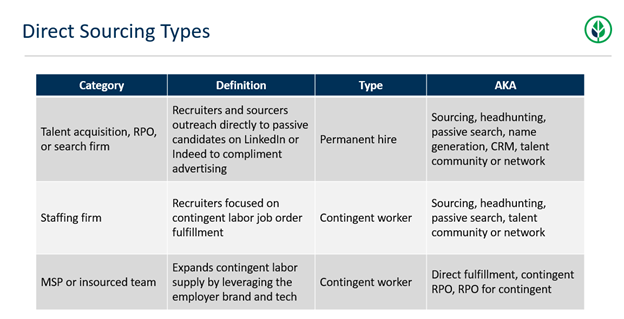
Broadleaf’s Jason Krumwiede Discusses the Future of MSP Direct Sourcing
Broadleaf’s Executive Vice President, Jason Krumweide, participated in a Recruitment Process Outsourcing Association (RPOA) leadership forum where he discussed direct sourcing. As an RPOA board member with 20+ years of recruiting, management consulting, and outsourcing industry expertise, Jason is optimistic about the future of direct sourcing and the success it could bring to the talent acquisition and workforce solutions industry. However, Jason believes that to achieve this success, a better definition and consistent use of direct sourcing is needed—as the term carries a different meaning depending on the stakeholder and service provider—confusing clients and business leaders in the staffing industry.
Current trends across the industry
Flexibility in talent strategy has become increasingly critical in today’s uncertain economy, and companies are leaning on contingent workers and direct sourcing strategies from their Managed Service Program (MSP) partners.
- The ability to plug in a contractor specifically to fill a gap or skill set has become incredibly important to companies as they navigate economic headwinds.
- Sixty-two percent of enterprise organizations that use contingent workers have either implemented a direct sourcing program or plan to in the near future as part of their MSP or insourced programs.
- Direct sourcing to help augment contingent labor programs is still in the early adopter phase and needs to develop on the maturity curve.
Navigating the confusion
Direct sourcing in the staffing sector is “a value-add service of an MSP provider or organization’s insourced team. By leveraging their data and corporate employment brand to attract candidates, direct sourcing expands the contingent labor supply,” states Jason. However, the challenge lies in knowing what type of direct sourcing to utilize based on your organization and its needs.
There are three types of direct sourcing, each fitting into different recruitment service delivery categories. The chart below depicts the categories of providers and their focus.

Criteria used to determine direct sourcing readiness
You may be ready to implement a direct sourcing solution if your organization answers yes to one or all of the following questions.
- Are you looking to fill challenging job categories or skill sets faster—often corporate or professional roles?
- Are you seeking cost savings? MSPs can payroll referred candidates at a lower markup than staffing providers.
- Are you interested in capitalizing on the career site traffic created by your strong employment brand? Utilizing a strong employment brand is a crucial delivery channel for direct sourcing success.
Related: The Top Reasons Direct Sourcing Programs Fail
Six best practices of direct sourcing programs
Here are some best practices to consider when developing and managing a direct sourcing program.
- Contingent labor is a complex process with many handoffs. An organization needs to invest in the correct technology platforms, such as LiveHire or Opptly, to establish entrance into the direct sourcing ecosystem.
- Encouraging people to opt into your talent community either as a direct employee or contractor is essential. Even if a candidate applies for a full-time position, you want them to feel inclined to learn more about your company and any potential contract positions as they become available.
- Segment the population to ensure the delivery of relevant information.
- Curating the talent community requires constant communication with candidates and providing them with engaging information about your company.
- Pushing out relevant jobs, especially via text message, is the primary and best way to reach your contractor talent pool due to its speed and perceived engagement level.
- While there is often a focus on the technology involved in this process, recruiting remains essential to “pulling” an interested candidate through the hiring process.Related: Improve Talent Curatation with Direct Sourcing
Benefits of direct sourcing
Direct sourcing offers several benefits to organizations that choose to adopt it.
- Cost savings: An MSP provider leverages an organization’s data and employment brand, driving cost savings into the program. Some companies spend over $50-$100 million in contingent labor. Using an MSP to payroll those referred employees and having a reduced markup compared to their staffing suppliers results in significant savings.
- Accelerated cycle times: An engaged talent community of contingent workers allows for accelerated submittal and processing times, resulting in greater efficiency.
- Leveraged silver medalist candidates: Direct sourcing offers opportunities to monetize silver medalist candidates who expressed interest in a role but were not selected.
- Overall enhanced candidate experience: AI in direct sourcing helps drive efficiency and engagement through two-way text messaging that ensures instant communication with candidates.
Despite the confusion surrounding direct sourcing and its appropriate uses, its future is bright. By adopting data-capturing practices and monetizing such data with an investment in technology and AI, the utilization of direct sourcing in the workforce solutions industry will experience significant growth and success.
Watch the entire leadership forum broadcast here.




